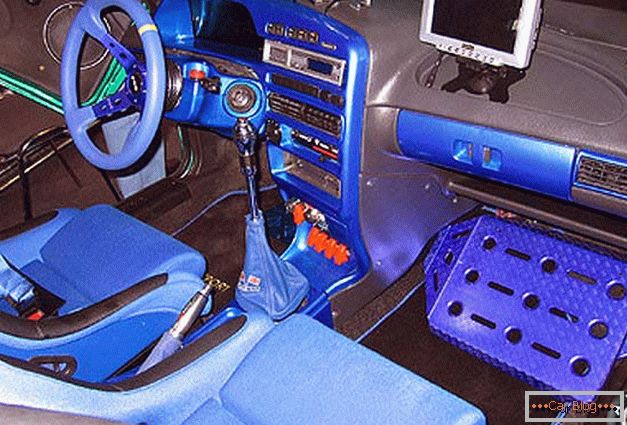Каждый автомобилист знает, что от правильно подобранных расходников зависят эксплуатационные характеристики автомобиля, а также срок службы транспортного средства. Особую роль в подобной ситуации играет моторное масло. Оно оказывает непосредственное влияние на параметры двигателя. В связи с этим автомобилистам должна быть известна decoding of engine oil labels, чтобы выбрать оптимальный по своим свойствам продукт.
Content
- 1 Modern classifiers lubricants
- 2 Use of SAE standard
- 3 Engine oil labels and API decoding
- 4 Marking on ACEA
- 5 State standard of the Russian Federation
- 6 Marking according to ILSAC
- 7 Certification rules
Modern classifiers lubricants
Almost complete information on the composition of motor lubricating fluid is located on the label. However, it is often written out in a certain form, in the form of symbols, abbreviations and abbreviations. Quick deciphering engine oil labels helps navigate the products offered and buy liquid with optimum performance. This will make it possible to significantly extend the engine life and ensure its normal operation.
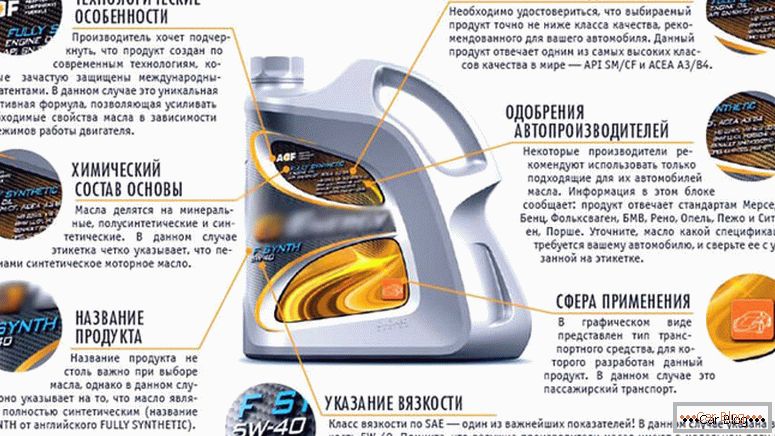
The main differentiation of oils is carried out according to the criteria related to the standards established in the world and operating in different regions of the planet. The most relevant and constantly improving are the following types:
- SAE - the development of the American classification from the Association of local motorists;
- API is a system introduced by the American Petroleum Institute;
- ILSAC - standards from the International Committee for Standardization and Testing of Oils, which is controlled by American and Japanese experts;
- ACEA - standards from European car manufacturers, used by leading companies in the continent;
- GOST - state standards that are binding on Russia and some countries of the former Soviet Union.
You need to know that the labeling of automotive oil is used for both diesel power plants and gasoline engines.
Also there are universal fluids that are designed to use them in different types of engines. The final composition of the oil manufacturers are prepared on a different basis:
- Mineral The liquid is obtained after processing of crude oil by the pyrolysis method, dividing the latter into fractions. The result is a relatively affordable material that performs well in the warm season, but its viscosity increases significantly as the temperature decreases. Also, the consumption of material is higher than that of analogues.
- Synthetic. Artificially derived material from various hydrocarbons. After fabrication, additives are added to it that enhance the characteristics of the initial product. Oils are well cleaned construction from carbon, promote better adhesion and minimize corrosion characteristics.
- Semi-synthetic. It has the characteristics of both types of previous fluids. It has advantages for all-season use.
Во время выбора товара стоит учесть, что стоит брать в расчет motor oil labeling value, относящихся к группам API, SAE и ГОСТ, так как именно они являются наиболее распространенными в нашей стране. Fans of Japanese or European transport are recommended to pay attention to ILSAC or ACEA.
Use of SAE standard
In this system, the decoding of engine oils for internal combustion engines is based on the viscosity of the source material. The result is three product groups:
- Winter varieties. The main objective of this variety is to provide a high degree of fluidity at low ambient temperature. This makes it easier to start the “cold” engine. In the label there is a symbol W and numbers that set the operating temperature. It is quite simple to determine the permissible minimum, since 35 should be subtracted from the specified value. Accordingly, the fluid with W10 marking is able to retain its parameters not lower than at -25C, and W15 is designed for -20C. For the hot period, such varieties should not be poured, since they will not save the motor from overheating.
- Summer varieties. Designed to operate at a positive ambient temperature. They have a higher viscosity than their winter counterparts, which allows them not to spread during the heat, but to hold onto the desired surfaces. For SAE, the labeling of such a product does not put a W or other letter, but only a numerical designation, for example, 40, 30 or 20, remains.
- Universal varieties. They are in demand among car enthusiasts living in regions with a less severe winter climate. Such markings for diesel or gasoline necessarily include two numeric values separated by the symbol W. An example is 15W-40, 10W-40 or 15W-30. Liquids adequately behave as at a reduced temperature, and during the warm period.
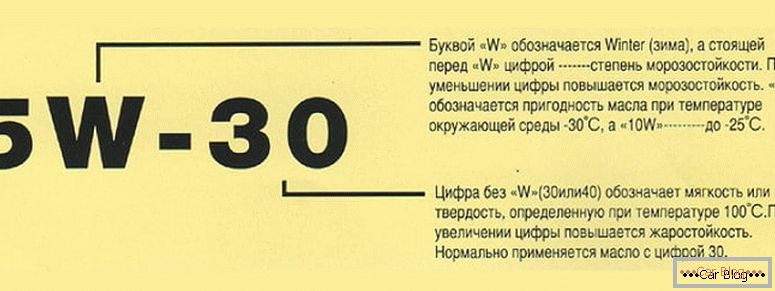
In relatively new cars up to 3-4 years old with low mileage, it is worth using grades of lubricants recommended by car companies. For cars with high mileage, you should give preference to liquids with high viscosity. This is due to the increase in technological gaps due to the development of mating elements, the drying out of the glands and the wear of gaskets. This minimizes oil leakage and reduces consumption.
Engine oil labels and API decoding
In the current Oil Classification System of the API Engine Service Classification System, division between groups of fluids according to the types of engines for which they are intended is proposed. Also taken into account is the period of release of transport, operating conditions and parameters of the oil itself.
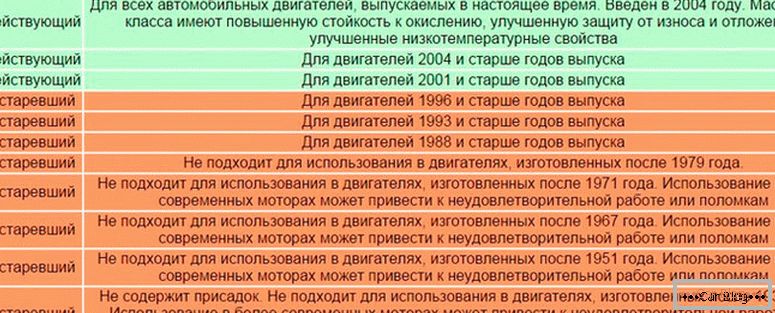
The difference in the labeling of gasoline and diesel products lies in the use of the letters S and C, respectively. When differentiating by operating parameters, the division is performed as follows:
- for energy-saving materials, ES is used;
- when Roman numerals follow the literal values, then it is possible to navigate through them in fuel economy when pouring this liquid;
- for the symbols defining the type of engine (diesel or gasoline), is a classifier of performance characteristics from A (minimum level) to N (highest class).
The universal product has a label indicating two categories, separated by a slash, for example, API SL / CF. In diesel oils, manufacturers typically use differences of 2 or 4 to indicate two-stroke and four-stroke powerplants.
If you use a lubricant of your own category, you will be able to reduce wear, minimize the risk of engine breakdowns, no deposit on the cylinder, pistons and valves, save fuel, reduce noise, optimize running parameters, and extend the operating life of the cleaning system and catalyst.
Marking on ACEA
European manufacturers have organized for their automotive companies their own standard for lubricating fluids. Its decoding includes the physicochemical properties, purpose and established category. The division of liquids is assumed according to three categories and a dozen classes:
- From A to B, passenger cars and minibuses are used regardless of the type of gasoline / diesel power plant;
- C marking is relevant for cars with catalysts;
- E demand for trucks equipped with a diesel engine.
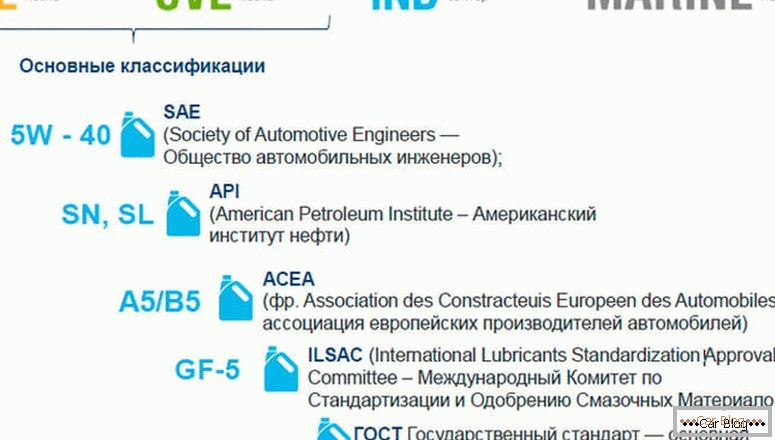
In addition to classes, the parameters of which can be learned from the corresponding ACEA table, the explanation describes the year of entry into force, as well as the sequence number of a particular publication.
State Standard of the Russian Federation
It is important to know that domestic manufacturers are guided by the standard GOST 17479.1-85, determining the marking of oils. In this case, open information for buyers must contain the following parameters:
- The level of kinematic viscosity. Based on this criterion, the oil belongs to the winter, summer or universal type. Values are summer even values in the range of 6–16, as well as 20, 24. Winter parameters from 3 to 6. The universal type is described by two values (summer / winter), divided by a slash.
- Scope of application. This marker divides the oil into six groups, which are marked in Cyrillic from A to E. This indicates the type of power plant in the designation, where 1 - for gasoline engines, and 2 - for diesel engines. When this value is absent, the product is allowed for use in both types of engines.

A domestic product may have several markings, both in accordance with GOST and according to European or American international standards.
Marking according to ILSAC
Manufacturers from Japan or America adhere to this certification. In this regard, the product is more relevant to our popular car brands, produced in the Land of the Rising Sun, for example, Honda, Suzuki, Mitsubishi, etc. The basic parameters in the five standards presented are identical to API criteria. At the same time ILSAC has energy-saving characteristics and applies to all-season lubricants.
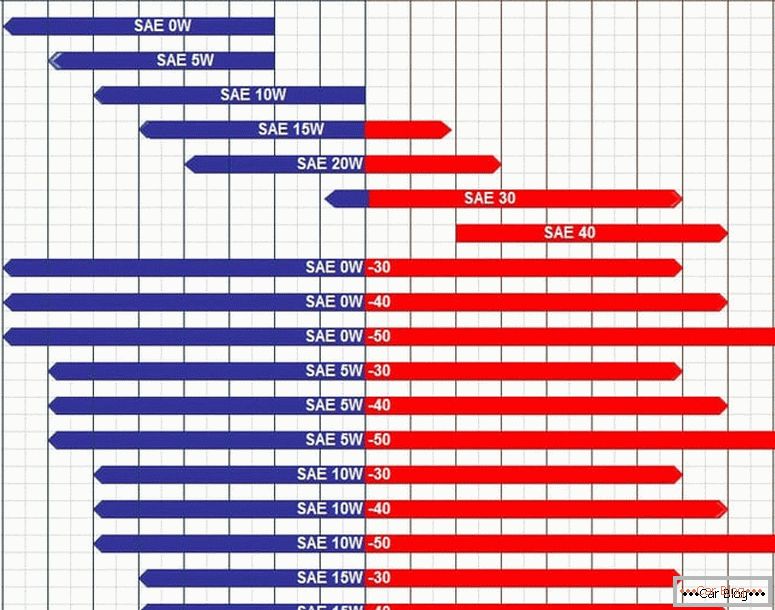
The JASO DX-1 group, demanded by turbocharged diesel internal combustion engines, has been allocated to an independent class. Special lubrication is useful for motorists also because it has high environmental performance.
Certification rules
For the systems ACEA and API there are several mandatory requirements that are obtained in mutual agreements between automakers and companies engaged in the release of fuel and lubricants. Sometimes auto companies issue prescriptions to their customers recommending certain brands of oils.
Such recommendations are formed during the empirical testing of cars. Previously, manufacturers send applications with their products for testing to auto enterprises. The monitoring process identifies the following preferred operational criteria:
- the viscosity of the formed film;
- type of base (synthetic / mineral water);
- what effect does lubrication have on the internal combustion engine;
- product reaction to temperature drops.
The admission for specific brands of cars of certain groups of oils is issued by the established type of certificate.

